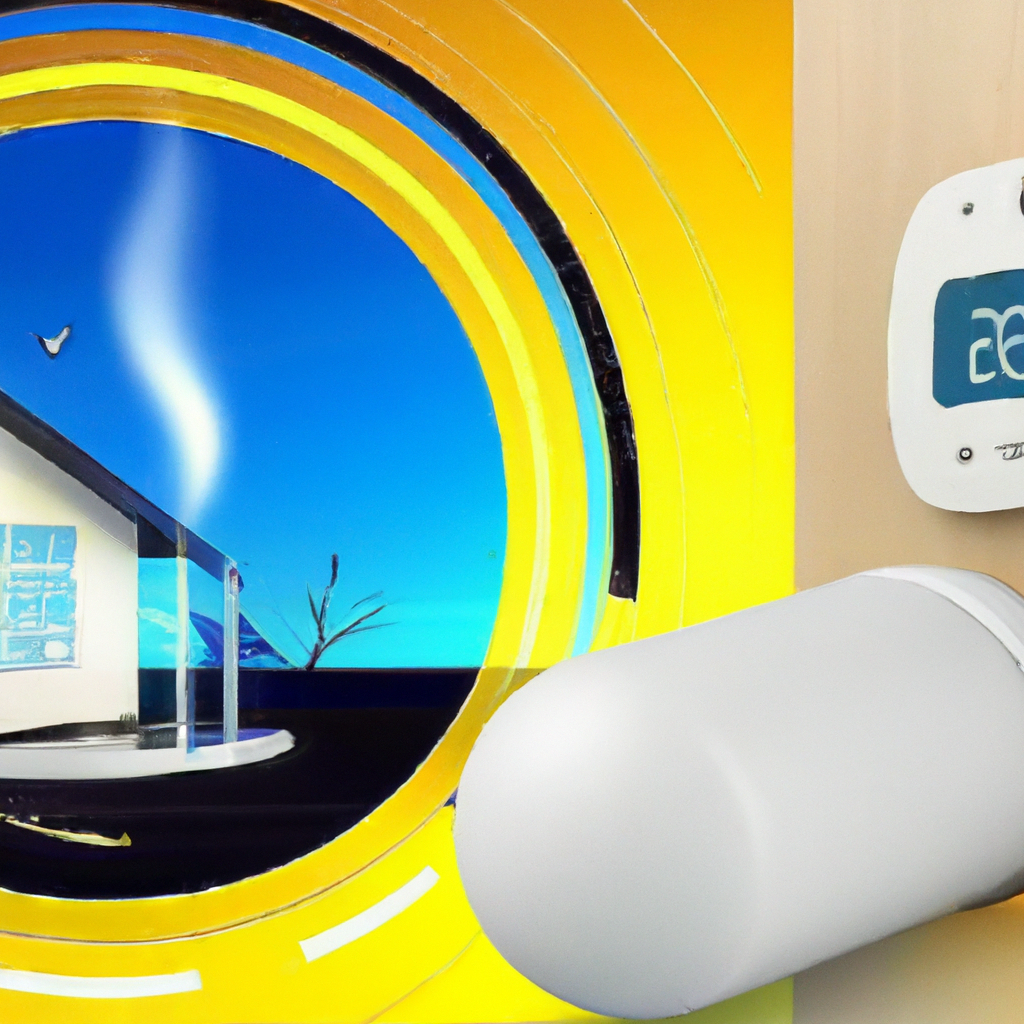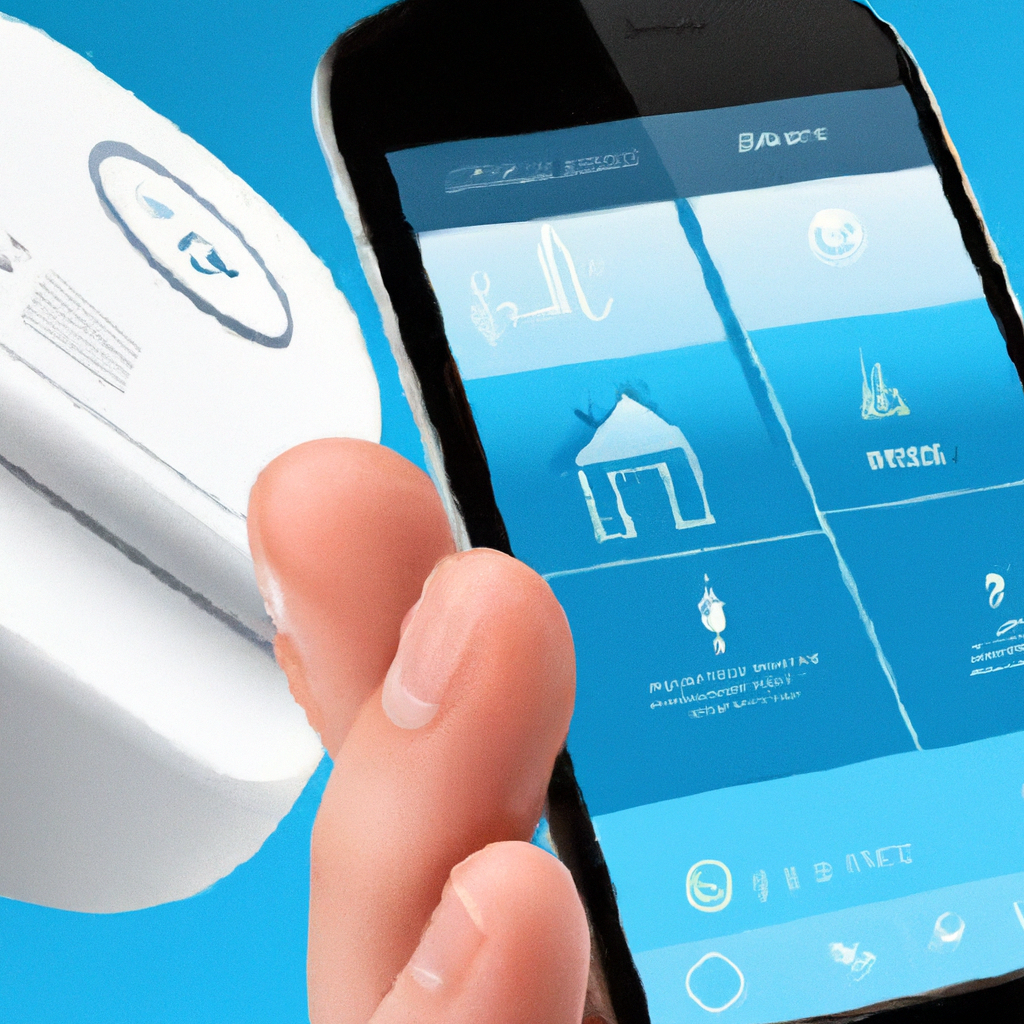You’ve probably heard the term “smart thermostat” thrown around, but what exactly are they, and how do they work? In a nutshell, smart thermostats are innovative devices that not only help you control the temperature in your home but also come with advanced features that can save you money and make your life easier. These intelligent gadgets connect to your home’s Wi-Fi network, allowing you to control them remotely through a smartphone app or voice command. With features like learning capabilities, energy usage tracking, and compatibility with smart home systems, smart thermostats are revolutionizing the way we manage our HVAC systems. So, let’s take a closer look at these marvels of technology and uncover how they can improve both your comfort and energy efficiency.

What Are Smart Thermostats
Definition of smart thermostats
Smart thermostats are advanced devices that are designed to control and regulate the temperature within your home. They are an innovative solution that combines technology, convenience, and energy efficiency to provide an enhanced and personalized heating and cooling experience. Unlike traditional thermostats, smart thermostats are equipped with various features and capabilities that allow you to remotely control and monitor your HVAC system using your smartphone, computer, or other smart devices.
Benefits of smart thermostats
There are numerous benefits to installing a smart thermostat in your home. Firstly, smart thermostats enable you to have better control over your HVAC system, allowing you to set and adjust temperature settings according to your preferences. This level of control can greatly improve comfort and convenience in your living space.
Another significant advantage of smart thermostats is their ability to learn and adapt to your lifestyle and usage patterns. By tracking your behavior and preferences over time, these devices can automatically create a customized heating and cooling schedule that maximizes energy efficiency and reduces wastage. This not only helps to lower utility bills but also contributes to a more sustainable and eco-friendly lifestyle.
Additionally, smart thermostats offer the convenience of remote access, allowing you to control and monitor your home’s temperature settings from anywhere, whether you’re at work or on vacation. This feature ensures that you can always come back to a comfortable home without wasting energy unnecessarily.
Overall, smart thermostats provide numerous benefits, including enhanced comfort, energy efficiency, and convenience, making them a worthwhile investment for any homeowner.
Smart Thermostat Features
Wi-Fi Connectivity
One of the most notable features of smart thermostats is their ability to connect to the Internet via Wi-Fi. This connectivity enables seamless communication between the thermostat and your smartphone or other smart devices. By connecting to your home’s Wi-Fi network, smart thermostats can be controlled remotely, providing you with the flexibility to adjust temperature settings from anywhere.
Wi-Fi connectivity also opens up a world of possibilities for integrating your smart thermostat with other smart home devices. This allows for a more comprehensive home automation system where you can control multiple aspects of your home’s environment with just a few taps on your smartphone.
Learning Capabilities
Smart thermostats go beyond basic temperature control by incorporating learning capabilities into their systems. These devices are equipped with sophisticated algorithms that analyze data about your usage patterns, such as when you typically leave and return home, and what temperatures you prefer at different times of the day.
By learning from this data, smart thermostats can automatically adjust your home’s temperature settings to maintain your desired comfort level without requiring manual input from you. Over time, they become more accurate in predicting your needs and can create personalized schedules that optimize energy usage.
Mobile Apps and Remote Access
The integration of mobile apps into smart thermostats allows for seamless control and monitoring of temperature settings even when you’re not at home. With these apps, you can easily adjust the temperature, set schedules, and access other features and settings directly from your smartphone or tablet.
Remote access to your smart thermostat provides flexibility and peace of mind. Whether you’re running late and want to ensure a comfortable temperature upon your arrival or want to conserve energy while you’re away, the ability to control your thermostat remotely offers convenience and control over your home’s climate.

Types of Smart Thermostats
Programmable Thermostats
Programmable thermostats are the predecessors to smart thermostats and offer some advanced features. These thermostats allow you to program temperature settings based on your weekly schedule. You can set different temperature levels for different times of the day or specific days of the week.
While programmable thermostats offer improved energy efficiency compared to traditional thermostats, they lack the learning capabilities and remote access features of smart thermostats. Nonetheless, they still provide greater control over your home’s temperature settings and can help to reduce energy consumption and costs.
Learning Thermostats
Learning thermostats build upon the capabilities of programmable thermostats by introducing machine learning algorithms. These thermostats are designed to learn from your behavior and usage patterns and automatically adjust temperature settings accordingly.
As you interact with a learning thermostat by manually adjusting the temperature or providing feedback, it adapts and fine-tunes its settings to align with your preferences. Over time, it can accurately predict and automatically create a personalized schedule that maximizes comfort and energy efficiency.
Smart Thermostats with Room Sensors
Smart thermostats with room sensors take customization to the next level by allowing you to control the temperature in individual rooms or zones of your home. These thermostats come with multiple sensors that can be placed in different rooms, providing a more accurate representation of the temperature throughout your home.
By utilizing room sensors, smart thermostats can adjust temperature settings based on occupancy and prioritize heating or cooling specific areas of your home. This level of granularity ensures that you achieve optimal comfort while minimizing energy waste.
How Do Smart Thermostats Work
Sensors and Data Collection
Smart thermostats rely on various sensors to collect data about the surrounding environment and the behavior of occupants. These sensors can include temperature sensors, humidity sensors, occupancy sensors, and ambient light sensors.
Temperature sensors provide accurate readings of the temperature in the room, allowing the thermostat to adjust the heating or cooling accordingly. Humidity sensors measure the amount of moisture in the air, which can affect comfort levels. Occupancy sensors detect whether a room is occupied or vacant, allowing the thermostat to adjust the temperature based on occupancy patterns. Ambient light sensors can determine the level of light in a room, which can influence heating and cooling needs.
By collecting data from these sensors, smart thermostats gain valuable insights into the thermal conditions and occupancy patterns of your home, enabling them to make intelligent decisions about temperature control.
Connectivity with HVAC Systems
Smart thermostats communicate with HVAC (heating, ventilation, and air conditioning) systems to control the temperature and air quality in your home. They connect to the HVAC system using wired or wireless connections, depending on the specific model and setup.
Once connected, smart thermostats can send signals to the HVAC system to turn on or off, adjust fan speeds, and control the flow of heated or cooled air. This communication allows for precise control over the temperature and airflow, ensuring that your home remains comfortable while minimizing energy consumption.
Learning Algorithms
The learning capabilities of smart thermostats rely on sophisticated algorithms that analyze data collected from sensors and user interactions. These algorithms use machine learning techniques to recognize patterns, predict behavior, and optimize energy usage.
As you interact with your smart thermostat and make manual adjustments, the algorithms analyze and learn from these actions. Over time, the thermostat becomes more accurate in predicting your temperature preferences and creates a customized schedule that aligns with your lifestyle. This continuous learning process helps to maximize energy efficiency while maintaining comfort in your home.

Installation and Setup
Compatibility with HVAC Systems
Before installing a smart thermostat, it is important to ensure compatibility with your existing HVAC system. Smart thermostats typically work with most modern HVAC systems, including furnaces, heat pumps, and central air conditioning units. However, it is advisable to check the manufacturer’s specifications and compatibility requirements to ensure a seamless installation process.
In some cases, you may need to have a professional HVAC technician assist with the installation, especially if there are wiring modifications or system compatibility issues. Consulting the product manual or reaching out to the manufacturer’s customer support can provide guidance on the installation process.
Connecting to Wi-Fi
To take full advantage of the features and capabilities of a smart thermostat, it must be connected to your home’s Wi-Fi network. The specific steps for connecting a smart thermostat to Wi-Fi may vary depending on the brand and model.
Typically, the process involves accessing the settings menu on the thermostat, selecting the Wi-Fi network, and entering the network password. Once connected, the thermostat will have access to the internet, allowing for remote control and monitoring.
Programming and Personalization
Setting up a smart thermostat involves programming temperature schedules and personalizing the settings according to your preferences. Most smart thermostats provide intuitive interfaces, either on the device or through a mobile app, that guide you through the setup process.
During setup, you will have the opportunity to define temperature settings for different times of the day or days of the week. Many smart thermostats also offer the option to create customized schedules for different zones or rooms in your home, allowing for greater temperature control and energy efficiency.
It is important to spend time familiarizing yourself with the features and settings of your smart thermostat to make the most out of its capabilities. Taking the time to personalize the settings can greatly enhance your comfort and energy savings.
Benefits of Smart Thermostats
Energy Efficiency
One of the primary benefits of smart thermostats is their ability to maximize energy efficiency. By learning your preferences, tracking occupancy patterns, and utilizing data from sensors, smart thermostats optimize temperature control to reduce energy waste.
These devices can automatically adjust the temperature when you’re away from home or asleep, ensuring that energy is not wasted on heating or cooling an unoccupied space. By avoiding unnecessary heating or cooling, smart thermostats help to lower utility bills and minimize the environmental impact of your HVAC system.
Cost Savings
Smart thermostats can lead to significant cost savings by reducing energy consumption and optimizing heating and cooling schedules. By fine-tuning temperature settings based on occupancy and usage patterns, smart thermostats minimize the need for excessive heating or cooling, thereby reducing energy waste.
Additionally, remote access and real-time monitoring capabilities allow you to make adjustments to temperature settings on the go, ensuring that energy is not wasted in your absence. These proactive measures can result in substantial savings on utility bills over time, offsetting the initial investment of the smart thermostat.
Convenience and Comfort
Smart thermostats offer unparalleled convenience and comfort by providing remote access and personalized temperature control. The ability to adjust temperature settings from anywhere using your smartphone or other smart devices allows you to come back to a comfortable home without wasting energy unnecessarily.
Learning algorithms and adaptive scheduling ensure that your home is heated or cooled to your liking, without the need for constant manual adjustments. This hands-off approach to temperature control provides a seamless and hassle-free experience, allowing you to focus on other aspects of your daily life.
The ability to create customized schedules for different zones or rooms in your home further enhances comfort and allows you to tailor temperature settings according to individual preferences. Whether you prefer a cooler bedroom for sleeping or a warmer living room for relaxation, smart thermostats enable personalized comfort for every member of your household.

Smart Thermostats and Home Automation
Integration with Smart Home Devices
Smart thermostats are integral components of a larger home automation ecosystem. They can integrate seamlessly with other smart home devices such as smart lighting systems, voice assistants, and security systems.
By connecting your smart thermostat to other devices, you can create intelligent automation scenarios that optimize energy usage and improve the overall functionality of your home. For example, you can have the thermostat automatically adjust the temperature based on the status of your security system or turn off the HVAC system when you leave the house.
Integrating your smart thermostat with other smart home devices opens up a world of possibilities for enhanced control, convenience, and energy efficiency.
Voice Control and Virtual Assistants
One of the most popular features of smart thermostats is their compatibility with virtual assistants and voice control technologies. With virtual assistants such as Amazon Alexa or Google Assistant, you can control your smart thermostat simply by using voice commands.
This hands-free control eliminates the need for physical interaction with the thermostat and provides a convenient way to adjust temperature settings while multitasking or when your hands are full. Voice control also allows for seamless integration with other smart home devices, allowing you to create comprehensive automation scenarios using just your voice.
Popular Smart Thermostat Brands
Nest
Nest, now a part of Google, is a leading brand in the smart thermostat market. Their flagship product, the Nest Learning Thermostat, revolutionized the industry with its sleek design, advanced learning capabilities, and intuitive interface. The Nest Learning Thermostat utilizes machine learning algorithms to create personalized schedules based on occupancy and temperature preferences, ensuring optimal comfort and energy efficiency.
Ecobee
Ecobee is another well-known brand in the smart thermostat industry. Their smart thermostats are known for their compatibility with a wide range of HVAC systems and their focus on energy efficiency. The Ecobee thermostats come equipped with room sensors that can monitor temperature and occupancy in multiple rooms, providing a more accurate representation of your home’s climate. This granular control allows for personalized comfort and energy savings.
Honeywell
Honeywell has a long-standing reputation in the HVAC industry and has entered the smart thermostat market with its line of connected thermostats. Honeywell smart thermostats offer a balance between features and affordability. They provide a user-friendly interface and compatibility with most HVAC systems, making them a popular choice for homeowners looking to upgrade to a smart thermostat.
Emerson Sensi
Emerson Sensi thermostats combine simplicity and functionality. Known for their easy installation process and intuitive interface, Sensi thermostats offer compatibility with most HVAC systems, making them a popular choice for DIY enthusiasts. Their mobile app provides remote access and control, allowing you to monitor and adjust temperature settings from anywhere.

Considerations and Limitations
Compatibility with HVAC Systems
While most smart thermostats are compatible with a wide range of HVAC systems, it is essential to check the compatibility of the specific model with your existing system. Some older or specialized HVAC systems may have limitations or require additional hardware to work with a smart thermostat. Checking the manufacturer’s specifications and consulting with an HVAC professional can ensure a seamless installation process.
Privacy and Security Concerns
Smart thermostats, like any other internet-connected device, raise privacy and security concerns. These devices collect data about your occupancy patterns and temperature preferences to provide personalized heating and cooling. It is important to ensure that the manufacturer has robust security measures in place to protect your data and that you are comfortable with the level of privacy implications.
Manufacturers providing regular firmware updates and implementing encryption protocols can help mitigate security risks. Additionally, reviewing the manufacturer’s privacy policies and opting for reputable brands can ensure that your data is handled responsibly.
Initial Investment and Payback Period
Smart thermostats often come with a higher price tag compared to traditional thermostats. However, the potential energy savings and reduced utility bills can offset the initial investment over time. The payback period varies depending on factors such as energy costs, usage patterns, and the specific model of the smart thermostat.
It is advisable to calculate potential energy savings and estimate the payback period before investing in a smart thermostat. While the initial cost may be a barrier for some, the long-term benefits and energy savings make it a worthwhile investment for many homeowners.
Conclusion
Smart thermostats offer a range of benefits, from enhanced comfort and convenience to energy efficiency and cost savings. With features such as Wi-Fi connectivity, learning capabilities, and mobile apps, these devices provide unparalleled control and ease of use. By integrating with other smart home devices and incorporating voice control, smart thermostats become an integral part of a comprehensive home automation system.
Popular brands such as Nest, Ecobee, Honeywell, and Emerson Sensi offer a wide range of options to suit different preferences and budgets. It is important to consider compatibility with your HVAC system, privacy and security concerns, and the initial investment when choosing a smart thermostat.
In conclusion, smart thermostats are a valuable addition to any home, providing a personalized and energy-efficient solution for temperature control. With their advanced features and capabilities, they have the potential to greatly enhance comfort, convenience, and sustainability. So, if you’re looking to upgrade your heating and cooling system, consider investing in a smart thermostat and experience the benefits firsthand.










